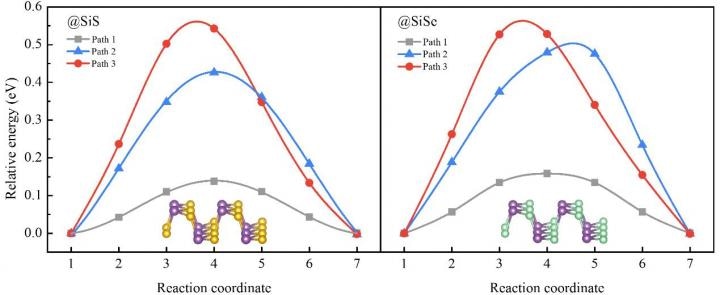May 19 2017
The development of high-performance energy storage systems is in urgent need to match the rapid growth in renewable energy technologies. Although lithium-ion batteries are among the modern systems that are extensively used at present, they have a number of drawbacks.
The lesser abundance of lithium makes it unsuitable to be used for large-scale energy storage. By contrast, sodium-ion batteries are highly promising as sodium costs considerably less. But the lack of suitable anode materials has hindered the development of sodium-ion batteries for a long time.
Certain anode materials used in lithium-ion batteries exhibit poor performance such as low specific capacity and slow kinetic response to large changes in volume during usage in sodium-ion batteries due to the larger molecular size of sodium when compared to that of lithium.
 These are the sodium diffusion barriers of phosphorene-like SiS and SiSe. CREDIT: Science China Press.
These are the sodium diffusion barriers of phosphorene-like SiS and SiSe. CREDIT: Science China Press.
A research group from The Hong Kong University of Science and Technology, headed by Professor T. S. Zhao, attempted to spot high-performance anode materials that are suitable for use in sodium-ion batteries. In the recent times, the Researchers performed first-principles calculations and have postulated that phosphorene-like SiSe and SiS can be the potential anode materials for use in sodium-ion batteries.
Phosphorene is a newly developed 2D material that has a favorable puckered surface. However, its use in sodium-ion batteries is hampered by its instability in the presence of O2 and H2O. In an endeavor to utilize the distinctive structure of phosphorene and overcoming its drawbacks, Professor T.S. Zhao and his colleagues suggested the use of phosphorene-like SiSe and SiS developed using the “atomic transmutation” technique as the anode materials for sodium-ion batteries.
The calculations indicated that the maximum Na/SiSe and Na/SiS ratios are 1.0, corresponding to the high theoretical specific capacities of 445.6 and 250.4 mAh g-1. Moreover, at the time of the whole sodium loading process, the changes in volume of SiSe and SiS are considerably small, thus guaranteeing better structural stabilities during the repeated charge/discharge cycle.
Of significance is the fact that sodium gets rapidly diffused on SiSe and SiS with energy barriers of just 0.158 and 0.135 eV. These values are considerably lower than those of traditional anode materials such as Na3Sb and Na2Ti3O7, which result in high rate capabilities for Na-ion batteries.